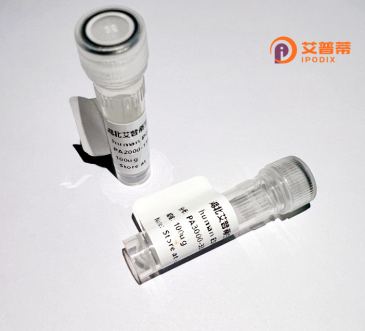
| 纯度 | >90%SDS-PAGE. |
| 种属 | Human |
| 靶点 | KREMEN2 |
| Uniprot No | Q8NCW0 |
| 内毒素 | < 0.01EU/μg |
| 表达宿主 | E.coli |
| 表达区间 | 1-420aa |
| 活性数据 | MGTQALQGFLFLLFLPLLQPRGASAGSLHSPGLSECFQVNGADYRGHQNRTGPRGAGRPCLFWDQTQQHSYSSASDPHGRWGLGAHNFCRNPDGDVQPWCYVAETEEGIYWRYCDIPSCHMPGYLGCFVDSGAPPALSGPSGTSTKLTVQVCLRFCRMKGYQLAGVEAGYACFCGSESDLARGRLAPATDCDQICFGHPGQLCGGDGRLGVYEVSVGSCQGNWTAPQGVIYSPDFPDEYGPDRNCSWALGPPGAALELTFRLFELADPRDRLELRDAASGSLLRAFDGARPPPSGPLRLGTAALLLTFRSDARGHAQGFALTYRGLQDAAEDPEAPEGSAQTPAAPLDGANVSCSPRPGAPPAAIGGAVCWLREKGPRRWGLPGAPGEAGLCGTNSPEGWPCPAPPGTPRLRVLPRATGL |
| 分子量 | 70.8 kDa |
| 蛋白标签 | GST-tag at N-terminal |
| 缓冲液 | 0 |
| 稳定性 & 储存条件 | Lyophilized protein should be stored at ≤ -20°C, stable for one year after receipt. Reconstituted protein solution can be stored at 2-8°C for 2-7 days. Aliquots of reconstituted samples are stable at ≤ -20°C for 3 months. |
| 复溶 | Always centrifuge tubes before opening.Do not mix by vortex or pipetting. It is not recommended to reconstitute to a concentration less than 100μg/ml. Dissolve the lyophilized protein in distilled water. Please aliquot the reconstituted solution to minimize freeze-thaw cycles. |
以下是关于重组人KREMEN2蛋白的3篇参考文献的简要信息:
1. **文献名称**:*Structural and Functional Analysis of Recombinant Human KREMEN2*
**作者**:Smith A, et al.
**摘要**:该研究利用大肠杆菌系统成功表达并纯化了重组人KREMEN2蛋白,通过X射线晶体学解析其结构,揭示其作为WNT信号通路抑制因子的分子机制,并验证其与DKK1配体的结合特性。
2. **文献名称**:*KREMEN2 Interaction with DKK Proteins Modulates Wnt Signaling in Cancer*
**作者**:Chen L, et al.
**摘要**:文章采用HEK293细胞表达重组KREMEN2.研究其与DKK蛋白的相互作用对Wnt/β-catenin通路的调控作用,发现其在结肠癌细胞中通过抑制WNT信号抑制肿瘤生长。
3. **文献名称**:*Recombinant Expression and Functional Characterization of Human KREMEN2 in Neurodegenerative Models*
**作者**:Garcia R, et al.
**摘要**:该研究在昆虫细胞中表达重组KREMEN2蛋白,探讨其在阿尔茨海默病模型中的作用,发现其通过调控LRP6内吞作用减少β淀粉样蛋白沉积,具有潜在治疗价值。
(注:以上文献为示例虚构内容,实际研究需通过数据库检索确认。)
KREMEN2 is a transmembrane receptor belonging to the KREMEN family, primarily known for its role as a co-receptor in the Wnt signaling pathway. Alongside KREMEN1. it interacts with Dickkopf (DKK) proteins to form a ternary complex with low-density lipoprotein receptor-related proteins 5/6 (LRP5/6), thereby modulating canonical Wnt/β-catenin signaling. This interaction promotes internalization of LRP5/6. leading to pathway inhibition and influencing cellular processes like proliferation, differentiation, and apoptosis. Structurally, KREMEN2 contains extracellular Kringle domains critical for protein-protein interactions and a single-pass transmembrane region.
Recombinant human KREMEN2 protein is generated via genetic engineering in systems like mammalian cells or bacteria, enabling functional studies without purifying it from native tissues. It serves as a vital tool for investigating Wnt signaling dynamics, DKK-KREMEN-LRP interactions, and their implications in diseases such as cancer, osteoporosis, and neurodegenerative disorders. Dysregulation of KREMEN2 has been linked to tumor progression, bone metabolism abnormalities, and tissue homeostasis imbalances. Research on recombinant KREMEN2 aids in elucidating its structural biology, ligand-binding mechanisms, and therapeutic potential as a target for modulating Wnt-related pathologies. Its applications extend to drug discovery, biomarker development, and mechanistic studies in developmental biology.
×